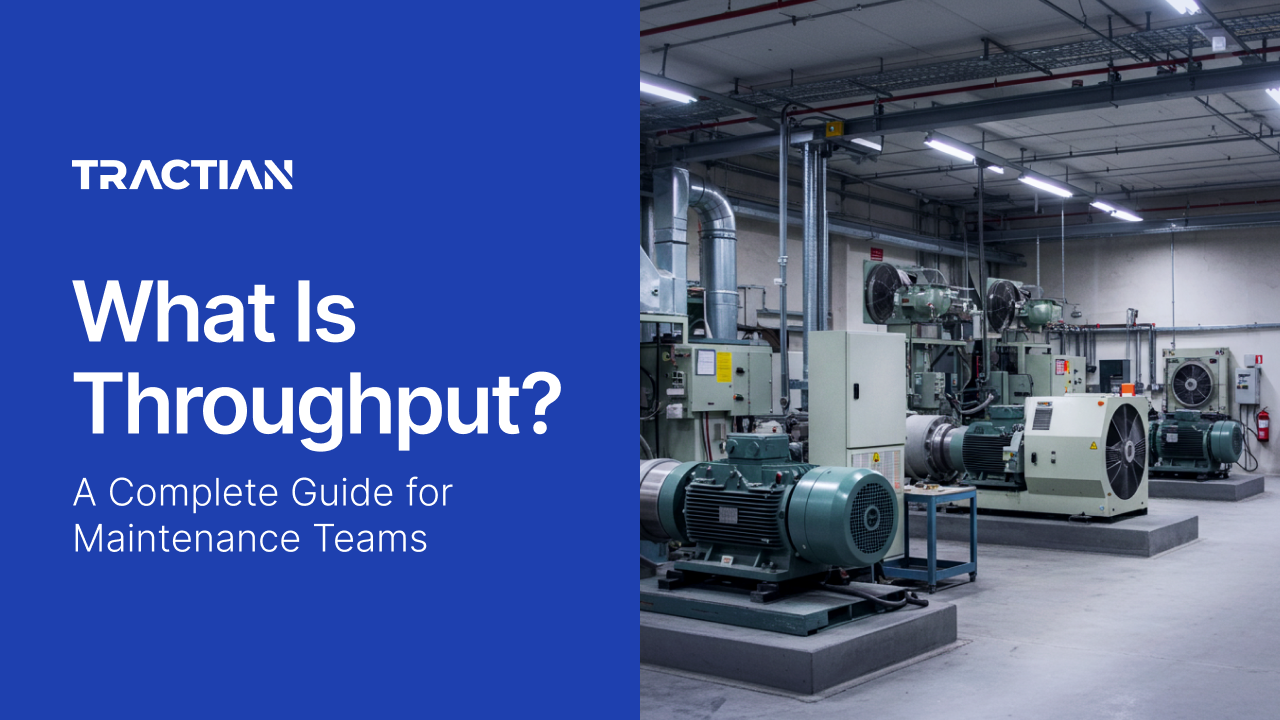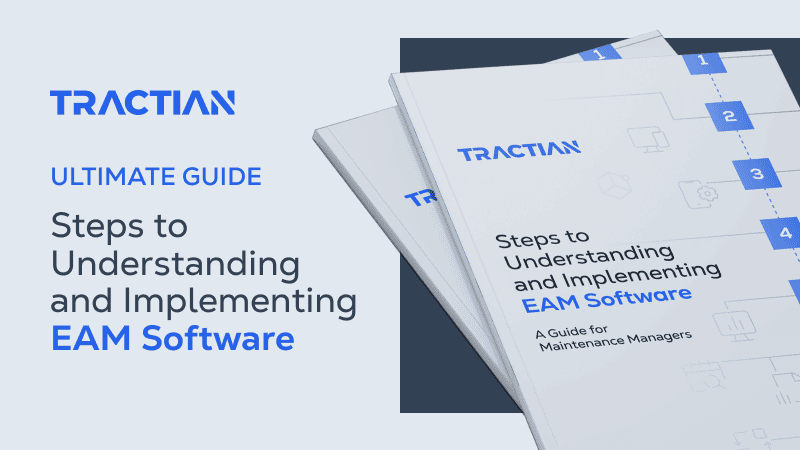When output drops, maintenance leaders don’t ask theoretical questions. They ask, "Why aren't we hitting our numbers?". And backing up the answer to that question is throughput, the clearest measure of how effectively your operation turns time and equipment into actual results-which are the numbers being asked about.
Throughput tracks the real output your system delivers over time. Not what the equipment could produce in ideal conditions, but what it actually does, under pressure, shift after shift. It’s the delta between design specs and operational reality, with maintenance playing the most critical role in narrowing that gap.
In this guide, we’ll break down how throughput works, how to measure it across different contexts, and how to use it as a lever for smarter maintenance strategies that drive performance, not just compliance.
Throughput Definition for Maintenance Teams
Throughput measures how much usable output your operation delivers over a set period of time. It’s not a projection or a best-case scenario, but the actual result of how well your equipment, labor, and processes perform under real conditions.
For maintenance teams, throughput is one of the clearest indicators of operational performance. When throughput drops, it often signals equipment inefficiencies, unplanned stops, or gaps in execution. When it holds steady, it means your maintenance strategy is supporting consistent output.
Also, throughput is not a one-size metric. It takes different forms depending on where you’re applying it:
- Manufacturing throughput: Units completed per hour or shift
- Process throughput: Volume of raw materials converted into finished goods
- Equipment throughput: Output rate of an individual machine or asset
- System throughput: Total output capacity of the full production line or facility
Regardless of the scope, the function remains the same: consistent throughput results from aligned maintenance, efficient execution, and reduced operational risk.
Key Factors Affecting Throughput
Once you understand what throughput measures, the next step is knowing what disrupts it. And that’s where maintenance has the most leverage. Every drop in throughput can be traced to a specific cause. Most of the time, it starts with something maintenance could control or prevent.
Each of the throughput factors below can be linked directly to plant performance:
Unplanned Downtime
Unplanned downtime is the fastest way to lose throughput. When a critical asset fails without warning, production doesn’t just pause. Everything backs up. One stop on one line can trigger delays across the entire plant.
To understand the hit on throughput from production asset failures, multiply your normal production rate by the time the equipment is offline. This will reveal the real impact breakdowns have on the numbers.
And it stacks up quickly. Emergency repairs, rush part requests, and last-minute labor all come at a premium. Worse, every unplanned event pushes scheduled maintenance aside, increasing the risk of follow-up failures and creating a cycle that’s hard to break.
Equipment Bottlenecks
Bottlenecks are the hidden limiters of throughput. They’re the points in your process where work piles up and flow slows down, even if everything else is running at full speed. All it takes is one underperforming machine to cap your entire system’s output.
To spot these constraint points, look at where throughput consistently stalls. Analyse which asset is always running at full capacity and where inventory builds up while upstream equipment waits. These buildup points are your bottlenecks, or constrained assets..
Once identified, these assets become your highest-leverage maintenance targets. Keeping them running smoothly delivers exponential returns. A single hour gained on a constraint machine often has more value than several on non-critical assets.
Scheduling and Labor
Maintenance planning is all about making sure those tasks don’t cost you throughput. Just as poorly timed work interrupts production, well-timed maintenance protects it.
The key is aligning labor availability with asset needs. That means more than just having techs on the clock. They need to be deployed where they’ll have the biggest impact, armed with the right tools, parts, and procedures to move quickly and avoid delays.
When maintenance labor is coordinated with production priorities, the result is fewer interruptions, faster recoveries, and a throughput curve that stays steady under pressure.
Formula And Ways To Measure Throughput
Measuring throughput with precision is what turns it into an efficient tool for decision-making. The formula itself is simple, but using it effectively requires choosing the right timeframes and applying it to the right data points.
Basic Throughput Calculation
The standard formula is:
Throughput = Total Output ÷ Time Period
That could mean units per shift, tons per day, or batches per week. What matters is aligning the time window with your plant’s operational rhythm, so the data you receive can actually drive change.
Let’s take a practical example. Say a packaging line is averaging 800 cases per hour. After revising the PM schedule, that same line consistently hits 832. That 4 percent gain is not just an efficiency boost. It’s direct proof that your maintenance plan is lifting output.
You can also calculate the throughput rate by looking at different time periods. Daily throughput provides visibility for short-term corrections, while monthly throughput reveals strategic trends. Both are necessary if you want your maintenance plan to do more than just reduce downtime.
Monitoring Tools
Throughput only becomes actionable when it’s tracked in real time and tied back to your maintenance activities. That’s where digital tools step in.
Modern CMMS platforms do more than log work orders. They track output, connect it to equipment history, and surface trends that would otherwise stay buried in spreadsheets. The value isn’t just in collecting data, but in making it visible and contextual.
To get the whole picture, throughput should always be analyzed alongside:
- Equipment efficiency rates
- Uptime and availability percentages
- Quality metrics and rework levels
- Maintenance cost per unit produced
When these metrics are connected, you stop guessing why throughput changes. You start to understand what’s working, what needs fixing, and where your next maintenance move will have the biggest impact.
How To Identify Bottlenecks And Boost Throughput
Once you're consistently tracking throughput, the next step is to use that data to eliminate limitations. We’re not talking about trial and error, but a structured approach to finding what’s holding back your output and fixing it with precision.

1. Map the Process
Begin by creating a clear flow diagram of your entire operation. Mark every key step, from raw material entry to finished product, and highlight throughput measurement points at each stage. This gives you a system-wide view of where things move efficiently and where they don’t.
Also, pay special attention to critical paths and dependencies, points where one asset’s performance controls what happens downstream. These are the levers where targeted maintenance work will make the most significant difference.
It’s not always the biggest machine that holds throughput back. Often it’s a smaller, overlooked component that’s quietly capping your entire system’s capacity.
2. Evaluate Asset Condition
It’s important to recognize that throughput begins with equipment reliability. Machines that run consistently at spec drive steady output. Assets in poor condition introduce delays, variability, and rework.
This is where preventive maintenance earns its keep. When equipment is kept in optimal condition, you avoid the surprises that force unplanned downtime and reactive labor.
To do so, use performance data to pinpoint the assets that carry the most weight. If a single failure on one line causes a drop in plant-wide throughput, that asset needs to be at the top of your maintenance priority list. Tools like a GUT matrix help organize those decisions based on gravity, urgency, and trend.
3. Implement Targeted Improvements
With constraints mapped and critical assets identified, the next move is action. But that doesn’t mean simply more maintenance. The goal is smarter maintenance, which keeps your high-impact equipment running without disruption.
Focus on practices that tighten your control over reliability and reduce downtime at key points:
- Preventive maintenance scheduling: Time maintenance activities during low-production periods to protect throughput
- Equipment standardization: Use uniform parts and procedures to simplify repairs and reduce time to resolution
- Spare parts management: Keep critical components readily available to eliminate avoidable delays
Here, prioritize the assets that limit your output and apply solutions that eliminate unnecessary interruptions.
Throughput Meaning Vs Similar Metrics
Throughput often gets lumped in with other performance indicators, but it's not interchangeable with them. Each metric tells a different part of the operational story, and understanding those differences helps maintenance teams act with more precision.
Lead Time
Lead time refers to the total time required to complete a process from start to finish. That includes every phase: waiting, processing, transit, and delays. Throughput, on the other hand, measures the rate of output over a given period of time. One is about how fast you’re producing, and the other is about how long it takes from initiation to completion.
However, the two are tightly linked because when maintenance minimizes breakdowns and keeps assets running consistently, throughput rises. As a result, lead time decreases.
Cycle Time
Cycle time measures the time it takes to complete one unit or one full pass through a specific process. It gives a clear view of how efficiently individual machines or workstations operate. Unlike throughput, which examines output over time, cycle time focuses on the duration of each task.
The relationship is straightforward: shorter cycle times lead to higher throughput. When maintenance streamlines equipment performance by reducing delays and eliminating inefficiencies, it lowers cycle time and increases throughput. Comparing cycle time and throughput helps pinpoint whether performance issues come from isolated machines or broader system constraints.
Capacity
Unlike throughput, capacity refers to the maximum output a system can produce under ideal conditions. No unplanned stops, no quality losses, no delays.
For maintenance teams, that gap is revealing. It shows how much potential is being lost to downtime, minor stoppages, or asset inefficiency. Tracking both helps you set achievable performance targets and measure how maintenance efforts are closing that gap over time.
Real World Gains From Improving Throughput
When maintenance teams prioritize throughput, the impact goes beyond production numbers. You see the results in efficiency, cost savings, and operational consistency across the board.
A good example is INPASA, one of the largest ethanol producers in Latin America. After implementing structured maintenance strategies with the help of Tractian’s technology, the company achieved a 0.80 percent increase in asset availability and recorded over $10 million in maintenance-related savings.
Improving throughput also tends to trigger gains in other areas, including expanded production capacity without additional capital, reduced emergency maintenance costs, greater reliability, and better delivery performance.
How Tractian's CMMS Can Elevate Your Throughput
Throughput is monumental. Yet, you’ll need to confront the fact that it's only as strong as the systems that support it. While most teams know how to spot inefficiencies, the real challenge is acting on them consistently across company assets, shifts, and teams. And this can’t be done if you rely on disconnected spreadsheets or outdated software.
This is where implementing a system like Tractian’s CMMS steps in. More than just a task manager, it’s built from the ground up for maintenance teams who need results, without unnecessary complexity.
Every layer of the platform is designed to help you plan smarter and execute faster. With drag-and-drop scheduling, you can align preventive maintenance with production windows, avoiding untimely disruptions. Work order prioritization and workload balancing help ensure the right tech is on the right job, without overload or idle time. And when a bottleneck asset goes down, your team already has AI-generated SOPs in hand to move fast, even offline.
Technicians track time automatically, follow detailed checklists tailored to each asset or failure type, and link parts directly to work orders, ensuring nothing gets lost in the process. Meanwhile, real-time dashboards provide supervisors with a comprehensive view of KPIs, including MTBF, availability, and backlog status, enabling them to identify issues before they impact throughput.
Beyond the floor, custom reporting by failure pattern or area lets you prove the impact of your strategy, justify investments, and keep leadership aligned with real numbers, rather than assumptions.
Finally, Tractian’s CMMS comes with a bonus benefit: its implementation doesn’t require you to stop or even hold you back. Tractian brings your existing data with you, structures it, and gets your team up and running live within a few days. No IT bottlenecks and no lengthy rollouts.



